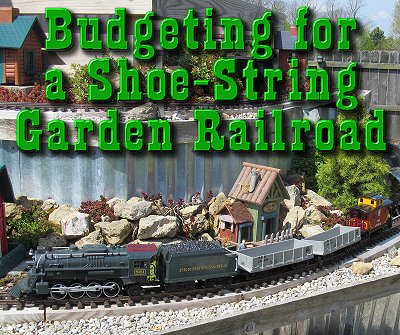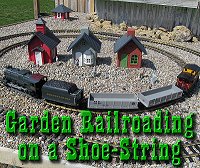 | |||
 |
 |
 | |
 |
 | ||
 |
 | ||
 |  | ||
 |  | ||
 | |||
 |
 |
 | |
 |
 | ||
 |
 | ||
 |  | ||
 |  | ||
Written by Paul D. Race for Family Garden Trains(tm)
 |
Budgeting for a Shoe-String Garden Railroad This is a companion article to our article on "Garden Railroading on a Shoe-String.
Most people who buy name-brand garden trains (from LGB, PIKO, etc.) imagine that they've made the "big" investment when they bring the train set home. Then they discover that additional track, water features, landscaping, plants, and accessories cost money, too. Even dirt is not "dirt cheap." This is a companion article to our article on "Garden Railroading on a Shoe-String.
Most people who buy name-brand garden trains (from LGB, PIKO, etc.) imagine that they've made the "big" investment when they bring the train set home. Then they discover that additional track, water features, landscaping, plants, and accessories cost money, too. Even dirt is not "dirt cheap."
The difference between me and almost all the other writers is that I tell you that up front. That said, I got into this hobby when we had small children and not much to spare. So I'm a big believer in scrounging, adapting, reusing, and otherwise using my ingenuity to cut down on costs. Everyone's situation is different, and you may wind up having to buy things that I have got free or vice versa. Just know that your train set will need to be coupled with other investments to get the best use out of it. Cost of Toy Trains - Most toy trains worth trying to run outside cost between $100 and $130 before Christmas. With any luck, you may be able to find them for half that after Christmas. Off-off brand trains will go even cheaper. Most toy trains come with enough curves to make a 48" circle and enough straight pieces to turn that into an oval or square, depending on your preference. The price of extra track for toy trains is outrageous, though. If, say, you are buying a set for half price after Christmas, and you can buy an extra set for less than $50, you might consider picking up two sets of the same brand, which will give you plenty of track, a spare locomotive, and usually another freight car or coach to add to the train you DO run. Otherwise, you may find yourself spending $25-$50 just on track. Alternatively, if your train set is a popular one, you may be able to find a use or damaged set for far less than the cost of additional track, and you might even get another car you can used with it. That said, if you're shopping the used market for your first train, make sure it's guaranteed to run and comes with the remote. Some of these trains won't run at all without the remote.
However you do it, if you set aside $100 for your train, chances are you'll be in the ballpark of what you wind up spending. Cost of Infrastructure - Other writers won't tell you that most garden railroads fail or at least need serious refurbishment within five to ten years because the track is not supported properly or because weeds aren't prevented from growing up through the track. This is even true of the folks who start out with thousands of dollars worth of trains. If you can put your track on a flat concrete patio or something, that's fine. But most folks don't have that luxury. They need to provide a "roadbed" that resists weeds and is strong enough to support even people accidentally stepping on the track (don't laugh, it happens to everybody eventually). If you want your track to be at ground-level, consider digging a 6"x6" trench and filling it with crack-resistant concrete. (According to the Quikrete folks' measurements, you'll need one bag for every 28" linear inches, so if you have 18.5 feet of track (the most that usually comes with these trains,), you'll need about eight bags. (As of April, 2020, in Springfield, Ohio, that will come to $32 plus tax)
If you want the dirt around your train to raise up to the level of your train, you'll need to take the cost of dirt and maybe a retaining wall into account, but know that you don't have to do this the first year, if your track is on a solid roadbed.
However you decide to provide support for your track, do not chintz on materials. Most products you can find in the garden supply sections of your area hardware and grocery stores are designed to fail within three years. That includes things like those oval-shaped "landscaping timbers" and many other products. Shop in the lumber and "hardscape" departments for the same products people use to make permanent improvements like decks and patios. I used "ground-rated" lumber when it's available, even for pieces that don't lie directly on the ground. In many cases it's the same price; you just have to shop carefully. If you want a waterfall or other water feature, you'll need to budget for that, too. Don't be surprised if they cost more than you'd expect. Depending on how you build, you may be able to add that later too. If you want a big pond, say over 150 gallons, you may want to install that first, though. Cost of the Garden - If you're good with plants and landscaping, you will already know of some ways to save money during this phase. However, you should have some idea of how much it will cost you to get enough plants and (maybe) little trees to provide a nice setting for your trains. Don't be embarrassed to start out with a lot of mulch, though. The most popular trees for garden railroads here in Ohio are Dwarf Alberta Spruce, and the size you probably want tends to cost about $10 each at the hardware stores' garden centers. Useful groundcovers will generally run you $3-5 a start. So you may be looking at $40-80 for a few trees and enough groundcovers and mulch to get you started. Unless you can find some trees for half-price after labor day. Buildings, Accessories, and Figures - You'll probably want a couple of buildings to start off with, but you don't have to invest in a whole city's worth starting out. There are ways to save money on figures, if you don't mind a little work and patience. Even if you just start out with a couple of bird feeders, you'll have some amount invested. Where is the Money-Saving Part of This? - If you're doing the math, you may have figured out that, not counting the train, I've added anywhere from $120-$400, depending how inventive you are and what compromises you are willing to make when you're first starting out. Ironically, ANYONE starting out with a train set they want to put outside will have the same sorts of expenses as well, even if they're starting out with a $400 train. Again, the differences between me and the other writers is that I'm warning you up front that the train set will hardly be your last purchase. The "Use Your Imagination" part of our article "Garden Railroading on a Shoe String" includes other suggestions for saving money on structures and accessories. Your Budget is Not Ironclad - You may be able to get some lumber from a neighbor tearing out a deck. You may have club-members near you willing to share starts of useful groundcovers, and so on. But once you've settled on a rough figure for each of these areas, and a rough overall total, you should be able to avoid spending too much money on inessentials. Don't laugh, people do that all the time. Like the bride with a $50,000 wedding budget who spends $45,000 on the dress and has to have Fazoli's cater the reception. It's possible to spend your entire budget on a single cool locomotive or car, and then you have nowhere to run it. ConclusionI hope this article helps you think about expenses you'll incurr trying to start an outdoor railroad, even if somebody gives you your first train.Do you have any new finds, techniques or recommendation you'd like to add to our information? If you do, especially if you can come up with how-to descriptions and photos, please get in touch. I'd love to post them here. Here are other articles with tips and tricks about running battery-powered toy trains outside.
|
Family Garden Trains is a participant in the Amazon Services LLC Associates Program, an affiliate advertising program designed to provide a means for sites to earn advertising fees by advertising and linking to amazon.com. For more information, please contact us |
 |  |
| Visit related pages and affiliated sites: | |||||
| - Trains and Hobbies - | |||||
 |  |
 |
 |
 |  |
 |

|

|  |
 |

|
| - Christmas Memories and Collectibles - | |||||
 |

|
 |

|
 |

|
| - Family Activities and Crafts - | |||||
 |

|

|

|

|

|
| - Music - | |||||

|
 |
 |

|

|

|

|

|

|

|

|

|

|

|

|

|

|

|